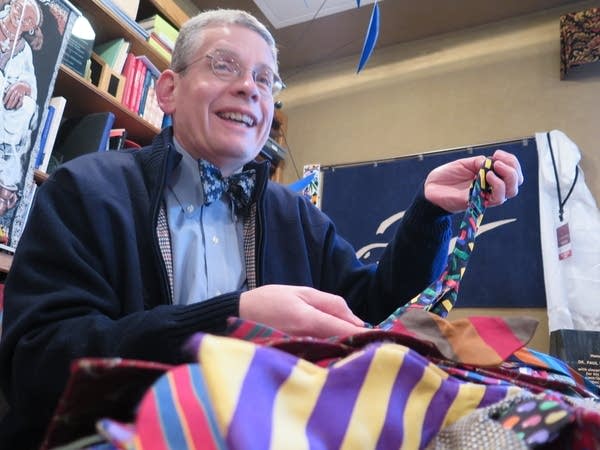The man leading a changing Augsburg

Go Deeper.
Create an account or log in to save stories.
Like this?
Thanks for liking this story! We have added it to a list of your favorite stories.

Want to spot the Augsburg president on campus?
Look for the guy with the bow tie.
It’s Paul Pribbenow’s signature look, and in cultivating it over the years, the 57-year-old has amassed a heck of a collection.
He throws several dozen ties onto a table in his office – about half of a collection he says numbers about 80 or 90 – to give me a look.
Turn Up Your Support
MPR News helps you turn down the noise and build shared understanding. Turn up your support for this public resource and keep trusted journalism accessible to all.
This one, he shows me, has the school colors. Here's a solar-system one. This band-aid-themed one I used to wear when I had to break bad news.
“A lot of it is about the students,” the president says. “It’s something they can make fun of. They recognize [me]. They actually ask for help to learn how to tie them.”

He's running a school that has its own subtle twists, I’m learning.
It’s a liberal-arts college with strong Norwegian Lutheran ties, and each year celebrates its traditional Scandinavian-style Christmas celebration. Quite cozy -- but not necessarily unusual here in Minnesota.
Yet over the past eight years, Augsburg’s demographics have shifted. Its traditional-age student body has gone from 12.6 percent people of color in 2006 to more than 30 percent – the most diverse four-year-college in the state behind Metropolitan State University.
Pribbenow says it has one of the largest percentages of Pell Grant recipients among Minnesota four-year colleges. (The number of Pell Grants is a proxy for the number of low-income students.)
And far from being the rambling college on the hill, Augsburg has 3,500 students wedged into just 23 acres in the dense Cedar-Riverside neighborhood – what Pribbenow says is one of the most diverse zip codes west of Chicago.
“We have no gates, we have no fences,” Pribbenow tells me. “The fluidity of our boundaries to the city and to the neighborhood are something that we really take seriously. That becomes almost an emblem of how we feel about the fact that the city is a classroom for our students.”

Mix the urban location with the Lutheran call to service, and you get a school that takes its “experiential education “ seriously -- to the point of getting national awards.
“Our students are in this daily working with neighbors, and it’s part of their education,” Pribbenow said. “This college has made experience equal to the classroom time. That’s something you’re not going to see at many colleges. They may talk about experiential education, but they haven’t integrated it fully into how they challenge students to learn. And it’s built into our curriculum.”
And that curriculum is solidly in the liberal-arts way of thinking.
Just look at what's coming up: The school hopes to break ground soon on a 140,000-square-foot Center for Science, Business and Religion, part of which should be up and running for Augsburg’s 150
th
anniversary in 2019.
The building – which is projected to cost more than $60 million – will handle labs, classrooms and office space for those departments. And Pribbenow says it should lead to a more integrated approach to those fields.
“What we’re actually creating is a place where all those intersections will be lived out day in and day out,” he said.

So I get the mix of science and business. And I get business and religion (business ethics).
But science and religion? Those two are usually at odds.
“That’s the epistemological challenge that we have in the world we live in,” he says. “People can’t imagine that science and religion can, in fact, be in conversation with each other. We’re trying to change that … to say, ‘You can be a person of faith and also a person who believes in what science provides us by way of understanding the world.”



